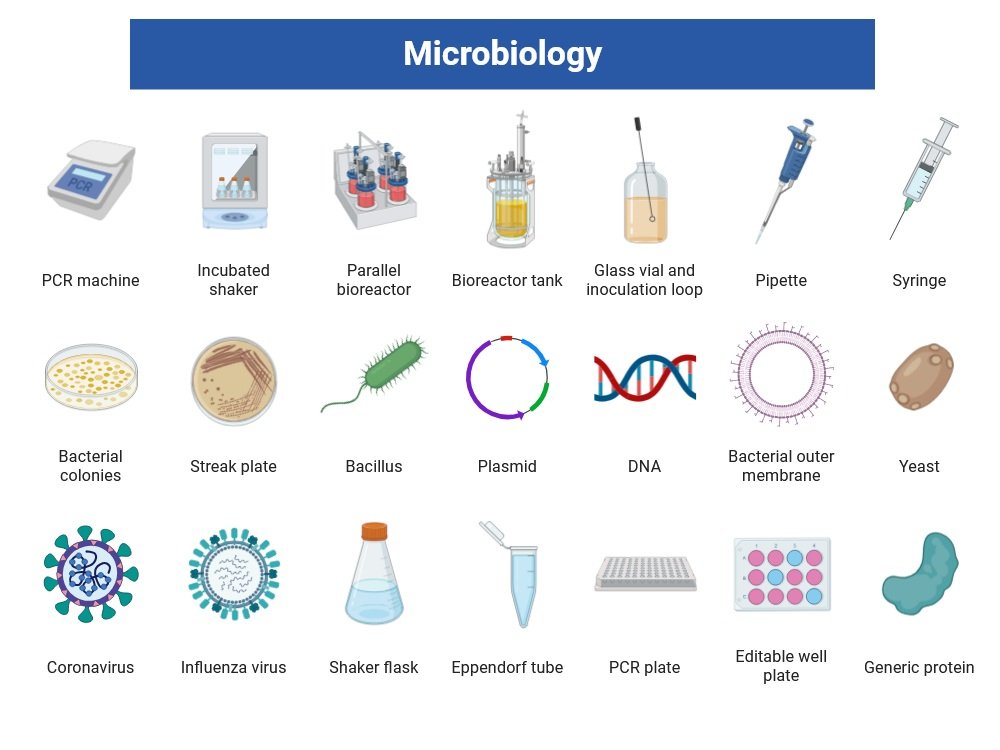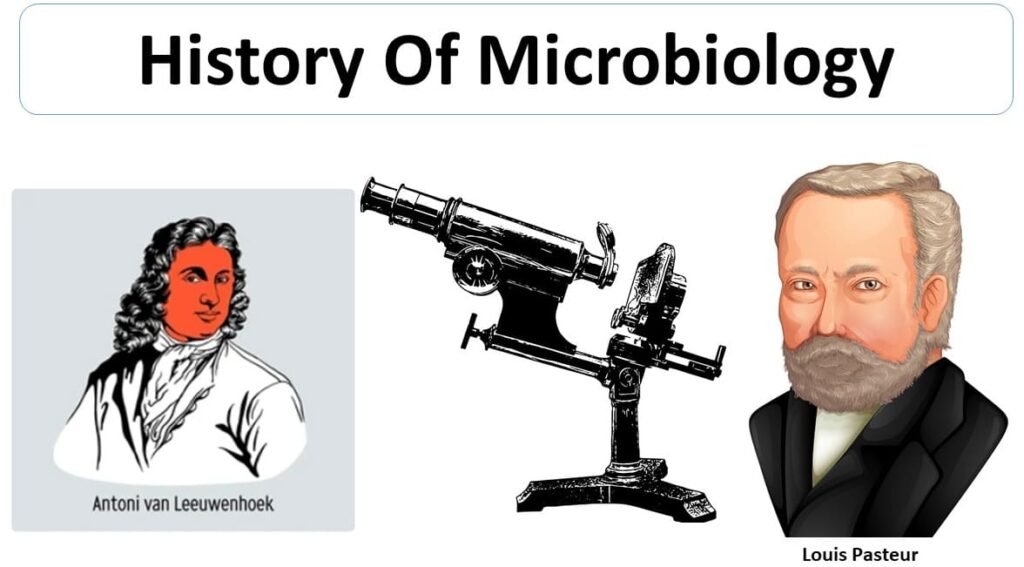Table of Contents
ToggleWhat is Microbiology?
Microbiology is the branch of science that deals with the study of microorganisms—microscopic organisms that are too small to be seen with the naked eye. These include bacteria, viruses, fungi, protozoa, algae, and microscopic parasites. Despite their minute size, microbes have shaped life on Earth for billions of years. Fossil evidence in Australian rocks shows microbial life existed as far back as 3.48 billion years ago, making them the oldest known life forms.
Although microorganisms are often associated with diseases, only about 1% of microbes are pathogenic. The rest play essential roles in maintaining ecosystems, supporting agriculture, aiding food production, and even benefiting human health.
This article explores what is microbiology? with history of microbiology, its branches, scopes, and wide-ranging applications, highlighting how microbes continue to influence science, industry, and daily life.

History of Microbiology
The history of microbiology is a fascinating journey that blends curiosity, scientific discovery, and groundbreaking medical advances. Below is a chronological overview:
- 1546 – Girolamo Fracastoro proposed the idea of contagious diseases, centuries before the microscope was invented.
- 1665 – Robert Hooke built a simple microscope and described cells for the first time, though he could not see internal structures.
- 1674 – Anton van Leeuwenhoek observed live microorganisms (“animalcules”), marking the true beginning of microbiology.
- 1740–1776 – John Needham and Lazzaro Spallanzani debated spontaneous generation—the theory that life could arise from nonliving matter.
- 1798 – Edward Jenner developed the world’s first vaccine, protecting against smallpox.
- 1839 – Theodor Schwann disproved spontaneous generation and discovered the organic nature of yeast.
- 1861 – Louis Pasteur introduced the concepts of aerobic and anaerobic growth and explained fermentation, establishing the Pasteur Effect.
- 1875 – Ferdinand Cohn classified bacteria and introduced the genus Bacillus.
- 1876 – Robert Koch demonstrated that Bacillus anthracis caused anthrax, supporting the Germ Theory of Disease.
- 1881–1882 – Robert Koch introduced solid media (agar) and staining techniques and discovered Mycobacterium tuberculosis.
- 1884 – Hans Christian Gram developed the Gram stain, still used today in bacterial classification.
- 1892 – Dmitri Ivanovsky identified the tobacco mosaic virus, laying the foundation for virology.
- 1910 – Paul Ehrlich developed Salvarsan, the first chemotherapeutic drug, to treat syphilis.
- 1928 – Alexander Fleming discovered penicillin, the first widely used antibiotic.
- 1946 – Discovery of bacterial conjugation, proving gene transfer in microbes.
- 1993 – Kary Mullis invented the Polymerase Chain Reaction (PCR), revolutionizing molecular microbiology and diagnostics.
Today, microbiology has expanded beyond infectious diseases into biotechnology, synthetic biology, genetic engineering, and environmental microbiology, making it one of the most interdisciplinary sciences.

Types of Microbiology
Microbiology is a vast field, divided into several branches:
1. Bacteriology
- The investigation of bacteria, their anatomy, physiology, genetics, and function in industry or disease.
- Includes beneficial bacteria (probiotics, biofertilizers) and harmful bacteria (pathogens).
- Used extensively in biotechnology, agriculture, and medicine.
2. Virology
- The study of viruses and similar organisms.
- Concentrates on the mechanisms by which viruses infect hosts, induce illness, and may be employed in vaccinations.
- Crucial in molecular biology and medical research.
3. Mycology
- The study of fungi, such as yeasts, molds, and mushrooms.
- It discusses food production, industrial applications (antibiotics, enzymes), and fungal infections (mycoses).
- Examines the role of fungi in biodegradation and the environment.
4. Parasitology
- Research on parasites (protozoa, helminths, Ectoparasites) and their relationships with hosts.
- Encompasses parasites of plants, animals, and humans.
- Crucial for veterinary/medical microbiology and disease management
5. Algology (Phycology)
- The study of algae, ranging from microscopic forms to seaweeds.
- Their role in the food, biofuels, and oxygen production industries is emphasized.
- Their ecological significance in aquatic ecosystems was also examined.
6. Protozoology
- The study of protozoa, which are unicellular eukaryotic creatures.
- Includes parasitic and free-living species.
- Numerous protozoa are responsible for illnesses such malaria, amoebiasis, and sleeping sickness.
Scope of Microbiology
Microbiology impacts almost every sector of society. Some key areas include:
- Medical Microbiology – Microbiologists are essential in the diagnosis and treatment of infectious diseases in the healthcare industry. They are employed in research facilities, diagnostic laboratories, and hospitals.
- Pharmaceutical Microbiology – Microbiologists are essential to the pharmaceutical industry’s research into antibiotics, vaccinations, and other treatments.
- Environmental Microbiology – Microbiologists in the environmental field deal with issues such as pollution control, waste management, and the creation of sustainable practices.
- Agricultural Microbiology – By researching the relationships between plants and microorganisms, they help increase crop productivity and soil health.
- Food & Beverage Industry – Fermentation, food preservation, and quality control.
- Industrial Microbiology – Production of enzymes, biofuels, bioplastics, and other microbial products.
- Academic & Research Careers – A large number of microbiologists are employed in universities and research facilities, where they teach and do research to advance their understanding of the subject.
Applications of Microbiology
Microorganisms have vast applications in healthcare, agriculture, industry, and research:
1. Understanding Microbes
- It gives us details on various kinds of microorganisms, allowing us to learn about their structure and functions, identifications and differentiations, classifications, nomenclatures (naming), and other characteristics.
- Their nutritional needs; their isolation and purification; their status as pathogens of plants and humans; to establish phylogenetic relationships (relationships according to developmental stages in the evolution of an organism) and to comprehend the genesis of life itself.
2. Microbes as Food
- Microorganisms as food: In addition to edible mushrooms, microorganisms are also being utilized as single-cell proteins in the form of yeast, bacteria, cyanobacteria, and fungus.
- For human consumption or as animal feed. Japan, Taiwan, Mexico, Israel, Thailand, and the United States are now producing the algal microbes as Chlorella (green alga) and Spirulina (cyanobacterium).
- Cellulose or lignocellulose produced by microorganisms can be used as human food either as it is or in the form of its products.
- Additionally, animal feed includes microbial products.
3. Fermented Foods
- Many fermented foods, including sourdough bread, leavened bread, fermented milk products, and tastes, are produced using microorganisms.
- Yogurt, cheese, and a variety of other items are examples of fermented dairy products.
4. Food Preservation
- Microbiology has been very helpful in food preservation through heat processing, pasteurization and appertization (commercially sterile food), thermal death value determination, prevention of food deterioration in cans, aseptic packaging, irradiation, UV radiation, ionizing radiation, high pressure processing, i.e., pascalization, low temperature storage (chill storage and freezing), chemical sulfur dioxide, nitrite, esters, and organic acids are all preservatives.
5. Industrial Microbiology
- Large-scale production of antibiotics, enzymes, amino acids, organic acids, and biofuels.
- Recombinant DNA technology enables production of insulin, growth hormones, and vaccines.
6. Genetic Engineering & Biotechnology
- The fantastic result of genetic engineering—the creation and manipulation of genetic material in vitro—is recombinant DNA.
- Genetic recombination is the process by which DNA from different sources is combined.
- A large number of restriction enzymes/restriction endonucleases have been isolated from various microorganisms that can either cut or cleave double-stranded DNA, leaving staggered ends.
7. Environmental Applications
- Bioremediation of oil spills, heavy metals, and pesticides.
- Wastewater treatment using microbial consortia.
- Carbon capture and methane-utilizing microbes for climate solutions.
Conclusion
Microbiology is not just about studying invisible organisms—it is about understanding the foundation of life itself. From saving lives through vaccines and antibiotics to revolutionizing industries with biotechnology, microbiology has shaped human civilization in countless ways.
The future of microbiology lies in synthetic biology, personalized medicine, sustainable agriculture, and climate resilience, making it one of the most impactful sciences of the 21st century.
Frequently Asked Questions (FAQ)
Q1. What is microbiology in simple words?
Microbiology is the study of microorganisms such as bacteria, viruses, fungi, protozoa, and algae that are too small to be seen without a microscope.
Q2. Who is the father of microbiology?
Louis Pasteur and Anton van Leeuwenhoek are often considered the fathers of microbiology for their groundbreaking contributions.
Q3. Why is microbiology important?
It helps in disease prevention, food production, biotechnology, agriculture, and environmental protection.
Q4. What are some real-world applications of microbiology?
Production of antibiotics, vaccines, fermented foods, wastewater treatment, and genetic engineering.
Q5. What is the future scope of microbiology?
Microbiology is expanding into synthetic biology, nanotechnology, personalized medicine, and bioenergy solutions.
Also Read
- Microbiology Experiments for Students: A Complete Guide
- Agriculture Microbiology Research Topics: Innovations Driving Sustainable Farming
- Food Microbiology Research Topics: Emerging Trends and Future Perspectives
- Parasitology: An Overview of Parasites, Diseases, and Host Interactions
- Antibiotics: Introduction, History, Mechanism and Applications
- Microbiology: From Microorganisms to Career Opportunities
- Spirulina: The Superfood Microalga with Limitless Potential
- Culture Staining Techniques in Microbiology: Types, Methods, and Applications
- Microbiology Notes
- Bacteriology Notes


Great post however I was wondering if you could write a litte more on this topic?
I’d be very grateful if you could elaborate a little
bit more. Cheers!
Sure, we are writing more about Microbiology, you can check other posts also related to microbiology. Thanks.
Its like you read my mind! You appear to know so much about this, like you wrote the book in it or something.
Thank you! I’m glad you found it helpful—I always aim to explain things clearly and in detail so it’s easy to understand. 😊